Compact MPV Verso 3rd generation, which appeared before the general public in 2009 at the Geneva Motor Show, was the debut of the European division of Toyota. Specialists from France worked on the design of the model, but they worked under the guidance of their colleagues from Japan. As for the restyling of 2013, we are talking about the first truly independent project of the European branch. Employees of the Toyota ED2 design office in Nice and the TME technical center in Belgium were involved in this project. All the details about what they did - read our review!
Design
In the process of updating, the compact van acquired a new corporate “face” and grew by 20 mm in length (up to 4.46 m): 15 mm fell on the front bumper, and 5 mm on the rear bumper. Despite this, in fact, Verso remains the most compact model that you can buy with a 7-seater saloon. The 2nd place in terms of compactness is occupied by the Opel Zafira Family - the difference in length is only 7 mm. 
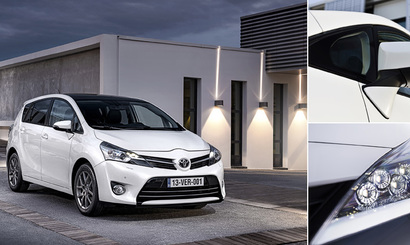 The new corporate style touched only the front part of the body, and everything behind remained unchanged. At the “stern”, the bumper was only slightly pointed and a black diffuser appeared. The restyling did not affect the lanterns and other parts of the rear, which is why it is extremely difficult to recognize the updated version by the “stern”. True, LEDs are now used as emitters in flashlights. The faceted-chopped front of the Verso contrasts slightly with the almost unchanged rear. Immediately striking is the predatory look of the headlights with spectacular LED garlands, between which there is an elegant radiator grille with chrome trim. You will meet such a car on the road - you involuntarily start to respect it. In general, the restyled van looks like a nice, solid car for every day.
The new corporate style touched only the front part of the body, and everything behind remained unchanged. At the “stern”, the bumper was only slightly pointed and a black diffuser appeared. The restyling did not affect the lanterns and other parts of the rear, which is why it is extremely difficult to recognize the updated version by the “stern”. True, LEDs are now used as emitters in flashlights. The faceted-chopped front of the Verso contrasts slightly with the almost unchanged rear. Immediately striking is the predatory look of the headlights with spectacular LED garlands, between which there is an elegant radiator grille with chrome trim. You will meet such a car on the road - you involuntarily start to respect it. In general, the restyled van looks like a nice, solid car for every day.
Design
Despite the fact that in the 1st generations Verso was called Corolla Verso, it has its own platform, is unique and has nothing in common with the Corolla chassis. Her suspension scheme is as follows: McPherson stands in front, and a twisting beam in the back. During the modernization, the shock absorbers on both axles have changed settings, the stiffness of the front suspension parts has increased and new struts have been applied. Rear stiffness has been increased with 34 additional weld points, and the ESD programs have been rewritten, which Toyota engineers say resulted in a slight improvement in handling.

Adaptation to Russian conditions
Verso is no more adapted to driving on Russian roads than the vast majority of other city cars, since it has only front-wheel drive and a modest ground clearance - 145 mm for the 5-seat version and 155 mm for the 7-seat version. In the trunk, depending on the configuration, a full-size spare wheel or dokatka is stored; in the "base" there is a conventional air conditioner, in the "top" - a separate climate control; of the heatings, there are only heatings for the 1st row seats and side mirrors, and affordable gasoline engines prefer fuel with an octane rating of at least 95.
Comfort
Thanks to restyling inside the compact van, it has become noticeably quieter - due to soundproof mats between the passenger compartment and the engine compartment. There are no architectural or layout innovations in the cabin - only the style of decoration has changed slightly and finishing materials have significantly improved. Soft plastic is mainly used for interior design, and the steering wheel is sheathed in high-quality Nappa leather (in all trim levels, except for the initial ones). The central armrest is also dressed in excellent leather. Matte decorative inserts of silver color are appropriate and look good against the background of dark details. The build quality raises no objections. The white color of the backlight on the new dashboard is much more pleasing to the eye compared to the previous amber backlight, and this is an absolute plus for readability. The instruments are located, as in the Toyota Prius - in the very center of the dashboard, which is unusual for many drivers. 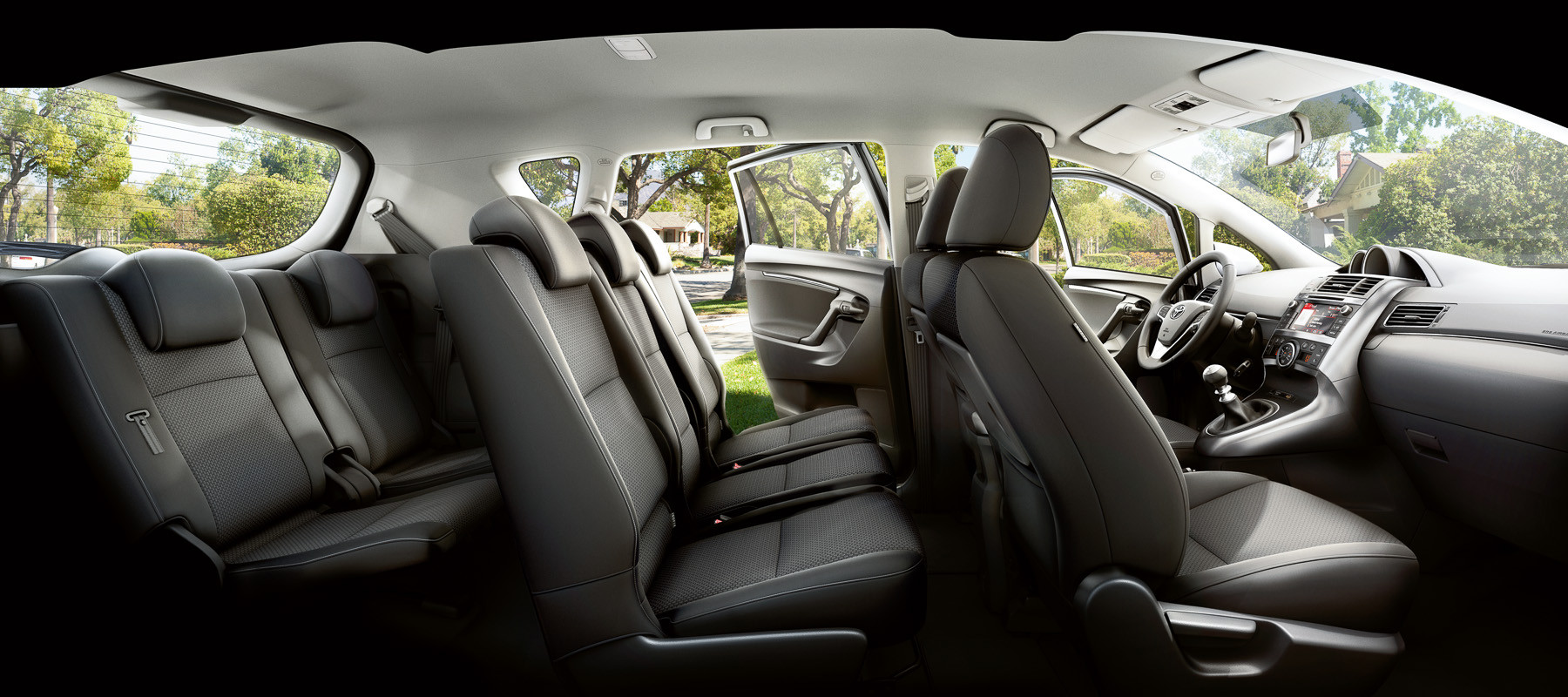
 There is plenty of storage space in the cabin, as before, and the upper part of the glove box divided in two tends to cool. Folding tables in the backs of the 1st row seats are very comfortable, with cup holders. As an option, a glass panoramic roof is available, which in the summer increases the level of comfort at times. The front seats are distinguished by a properly selected profile and not too pronounced lateral support. The presence of full-fledged separate seats on the 2nd row (modifications are also offered with the 3rd row, where, according to tradition, you have to make your way with difficulty) and a flat floor indicate that all rear riders will be equally comfortable. Those who sit in the "gallery" are deprived of side glazing and extra legroom - for the sake of extra space, they will have to ask those sitting in front to make room. As you'd expect from a compact car, the Verso's boot is moderately sized, with room for between 484 and 1,026 liters. luggage (with the rear seats folded down). When fully loaded with passengers, the 7-seat version has enough luggage space at best for a couple of small suitcases.
There is plenty of storage space in the cabin, as before, and the upper part of the glove box divided in two tends to cool. Folding tables in the backs of the 1st row seats are very comfortable, with cup holders. As an option, a glass panoramic roof is available, which in the summer increases the level of comfort at times. The front seats are distinguished by a properly selected profile and not too pronounced lateral support. The presence of full-fledged separate seats on the 2nd row (modifications are also offered with the 3rd row, where, according to tradition, you have to make your way with difficulty) and a flat floor indicate that all rear riders will be equally comfortable. Those who sit in the "gallery" are deprived of side glazing and extra legroom - for the sake of extra space, they will have to ask those sitting in front to make room. As you'd expect from a compact car, the Verso's boot is moderately sized, with room for between 484 and 1,026 liters. luggage (with the rear seats folded down). When fully loaded with passengers, the 7-seat version has enough luggage space at best for a couple of small suitcases.
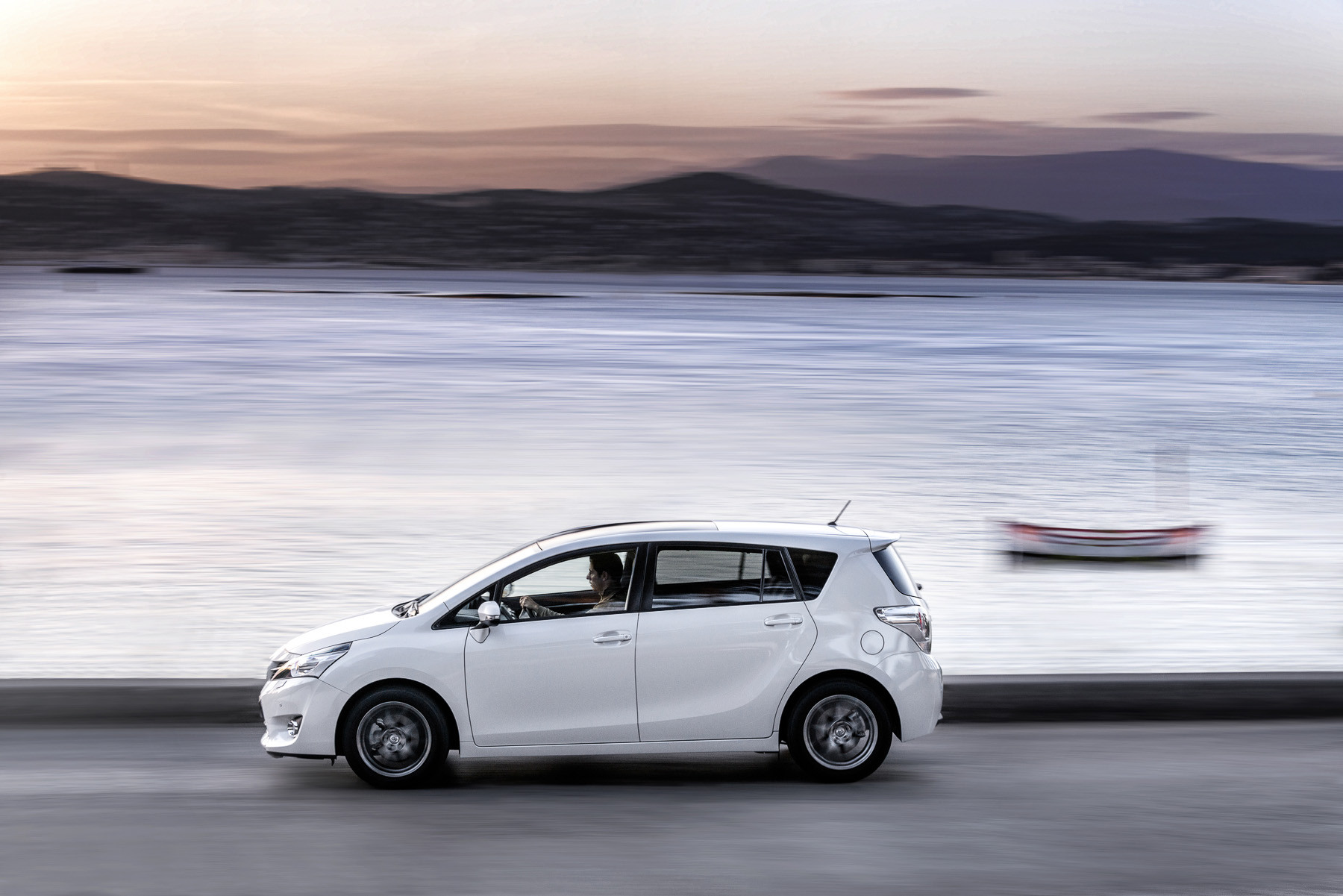
To evaluate the safety level of Verso, you need to look at the crash test results of the European independent organization Euro NCAP. In tests conducted in 2010, the compact van earned 5 out of 5 stars, demonstrating the following results: driver or adult passenger protection - 89%, child protection - 75%, pedestrian protection - 69%, electronic assistants - 86%. Achieving such results was made possible by rich equipment, which already in the basic version includes front and side airbags, curtains, anti-lock and traction control systems, as well as systems for stabilizing and distributing brake forces. For a surcharge, parking sensors are offered (“in a circle”), light and rain sensors, cruise control and a rear-view camera with dynamic markings.
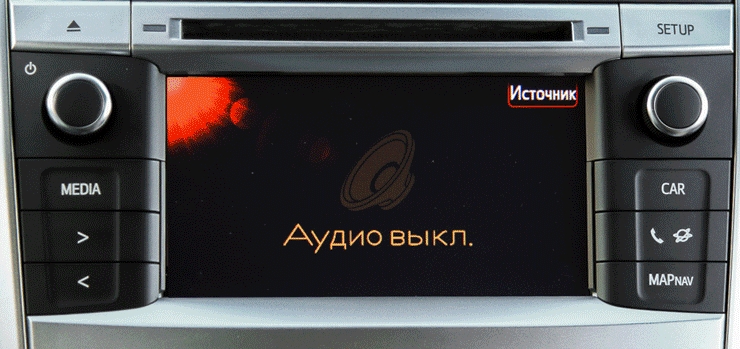
All Verso cars, except for the most inexpensive versions, are equipped with the Toyota Touch 2 multimedia system with a 6.1-inch color touchscreen, 6-channel acoustics and navigation. AUX / USB connectors and Bluetooth wireless protocol are responsible for connecting gadgets. The location of the AUX and USB inputs is not very good - on the side of the central tunnel on the passenger side, where flash drives and wires will constantly be at risk of damage from riders' legs. Navigation works clearly, only with the Russification of the problem - what are some colloquial words "eat" and "stop", bypassing the norms of the Russian language. Everything is in order with the graphics and speed of the media system, the sound is acceptable.
Toyota Verso Specifications
The update brought with it both a “refreshed” appearance and modified engines. The power units received Valvematic technology, which is a successful continuation of the Dual VVT-i variable valve timing system. We are talking about gasoline in-line "fours" with a volume of 1.6 and 1.8 liters. The first develops 132 hp. at 6400 rpm and 160 Nm at 4400 rpm, and the second produces 147 hp. at 6400 rpm and 180 Nm at 4000 rpm. The least powerful engine is paired with a six-speed "mechanics", and the most powerful is combined with a variable speed transmission (CVT). They do not provide impressive dynamics, but in general the dynamics are not bad. According to the manufacturer, the average fuel consumption is 6.6-6.8 liters. per 100 km, but the actual numbers may be different.

| Characteristic | Live, 1.6L, 6MT | Active 1.8 CVT | |||
|---|---|---|---|---|---|
| Engine's type: | Petrol, transverse | ||||
| Engine capacity: | 1598 | 1798 | |||
| Power: | 132 HP | 147 HP | |||
| Acceleration to 100km/h: | 11.7 s | 11.1s | |||
| Max Speed: | 185 km/h | 185 km/h | |||
| Consumption in the urban cycle: | 8.3/100km | 8.5/100km | |||
| Extra-urban consumption: | 5.6/100km | 5.8/100km | |||
| Combined consumption: | 6.6/100km | 6.8/100km | |||
| Fuel tank volume: | 60 l | 60 l | |||
| Length: | 4460 mm | 4460 mm | |||
| Width: | 1790 mm | 1790 mm | |||
| Height: | 1620 mm | 1620 mm | |||
| Wheelbase: | 2780 mm | 2780 mm | |||
| Clearance: | 145 mm | 145 mm | |||
| Weight: | 1430 kg | 1450 kg | |||
| Trunk volume: | 484 l | 484 l | |||
| Transmission: | Mechanical | Variator (CVT) | |||
| Drive unit: | Front | Front | |||
| Front suspension: | Independent, spring with MacPherson struts and anti-roll bar | ||||
| Rear suspension: | Semi-dependent with torsion beam | ||||
| Front brakes: | Disc, ventilated | Disc, ventilated | |||
| Rear brakes: | Disk | Disk | |||
| Production: | Turkey | ||||
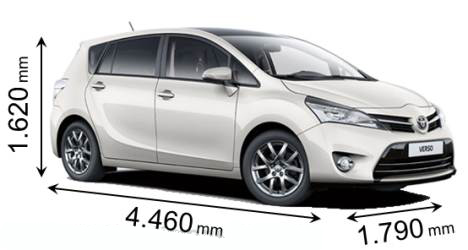
Dimensions Toyota Verso
- length - 4.460 m;
- width - 1.790 m;
- height - 1.620 m;
- wheelbase - 2.8 m;
- ground clearance - 145 mm;
- trunk volume - 484 liters.
Toyota Verso equipment
| Equipment | Volume | Power | Consumption (city) | Consumption (route) | checkpoint | Drive unit |
|---|---|---|---|---|---|---|
| Comfort 2WD | 1.6 l | 132 HP | 8.3 | 5.6 | 5MT | 2WD |
| Comfort 2WD | 1.8 l | 147 HP | 8.5 | 5.8 | CVT | 2WD |
| Comfort Plus 2WD | 1.8 l | 147 HP | 8.5 | 5.8 | CVT | 2WD |
| elegans 2wd | 1.8 l | 147 HP | 8.5 | 5.8 | CVT | 2WD |
| Prestige panorama 2WD | 1.8 l | 147 HP | 8.5 | 5.8 | CVT | 2WD |
| Prestige 2WD | 1.8 l | 147 HP | 8.5 | 5.8 | CVT | 2WD |
Toyota Verso photo

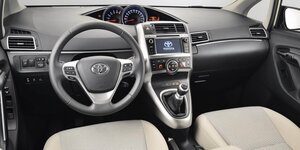
Test drive Toyota Verso - video

Advantages and disadvantages of Toyota Verso
The restyled Verso will appeal to those for whom are important:
Let's highlight the main advantages of the model:
- beautiful and modern appearance;
- high quality assembly and interior decoration;
- large capacity;
- rich equipment;
- moderate fuel consumption;
- good handling.
The disadvantages include:
- lack of automatic transmission as an alternative;
- whimsicality to the quality of gasoline;
- small clearance;
- no heated steering wheel and windshield;
- AUX and USB inputs are inconveniently located.
Other reviews
As one of the best-selling cars in the world, the Toyota Corolla never ceases to improve, as evidenced by the restyling experienced last year. As many reviews of car owners and test drives show, not all changes have benefited the four-door, but despite this, the new product definitely wins compared to the pre-styling model. Like its predecessor...
For more than 20 years, the Japanese corporation Toyota has been producing the RAV4 compact crossover, and by now it has managed to turn into something special, firmly rooted in people's minds, as a reliable and trustworthy car. And not just a car, but a really passable car, absolutely suitable not only for city trips, but also for cross-country driving. Become more...
The third-generation full-size crossover Toyota Highlander, introduced in 2014, underwent a significant upgrade at the end of 2016. Thanks to the update, the Highlander of the 2017 model year is now available on the Russian market - with a slightly changed appearance and a revised technical "stuffing". Despite the fact that its grille is emblazoned with a branded emblem...
